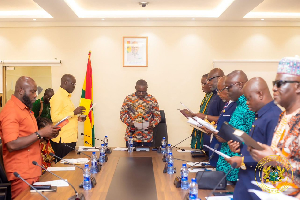IMANI-Africa has slammed the Electoral Commission(EC) for its flawed justification for the procurement of new BVRs and BVDs ahead of this year’s general elections.
According to IMANI, the wear and tear rate of these electoral technologies have been exaggerated describing as false, the comparison of the BVRs and BVDs with normal laptops and POS terminals.
“The thing about these BVRs and BVDs that have now captured the nation’s attention is that they are used very infrequently, only a few times a year in fact. That’s a far cry from a mobile phone, POS payment terminal or, indeed, normal laptop,” IMANI President, Franklin Cudjoe shared these insights on his Facebook page.
The IMANI Boss maintained that this among others are grounds for the CSO’s and Ghanaians at large being dismissive regarding the EC’s justification of new biometric infrastructure.
He added the dire consequence of the EC’s decision is imminent as existing facilities worth millions of cedis would be mothballed for a new one.
“the country would have to watch helplessly as over $60 million (accounting for depreciation) worth of technology systems are plucked out and discarded like garbage so that they can blow $150 million (accounting for contingency) on assembling a new end-to-end system.”
Full post published below
Shall soon be publishing a detailed IMANI update on the controversial voter register. First though, see two critical issues majority of Ghanaians and CSOs believe are grounds to reject the EC’s financial justifications.
1.a. In 2016, the EC spent millions of dollars on Biometric Voter Registration services (see below) and related peripherals to support that year’s elections. The EC has continually budgeted for and spent significant amounts of money running into millions of dollars every year to protect its IT systems from complete obsolescence. All the EC’s procurement plans and expenditure frameworks show clearly that the policy of Continuous Improvement & Upgrading has been the organisation’s strategic philosophy until the end of 2018, following the crisis that rocked the organisation’s leadership that year.
b. For instance, every time a new district is created, the EC budgets for new VSAT equipment and district-level Voter Management Systems (VMS) to enable biometric and biographical data captured during registrations to be transmitted to its central data center. As late as 2018, the EC was working on implementing as many as 38 of these systems.
c. It can therefore not be correct that the entire EC biometric infrastructure and associated electronic systems date to 2011, or that all the components of that overarching system are End-of-Lifecycle or End-of-Service. Many parts of the system are new and are in sound order. This has been a major confounding trick that the EC has used very effectively to hoodwink rational-thinking members of society.
d. If the EC is allowed to have its way, $40 million in fresh investments made over the 2016/2017 timeline shall simply be mothballed and dumped into a rubbish bin.
e. Also, the wear and tear rate of these systems has been exaggerated through a false comparison with normal laptops and POS terminals. The thing about these BVRs and BVDs that have now captured the nation’s attention is that they are used very infrequently, only a few times a year in fact. That’s a far cry from a mobile phone, POS payment terminal or, indeed, normal laptop.
f. As things stand now, with the EC having virtually completed its procurement process for a new NBVI without any regard for public opinion, the country would have to watch helplessly as over $60 million (accounting for depreciation) worth of technology systems are plucked out and discarded like garbage so that they can blow $150 million (accounting for contingency) on assembling a new end-to-end system. It is important to emphasise that electoral technologies worldwide have near-zero salvage value since there is no secondary market for second-hand electoral systems.













